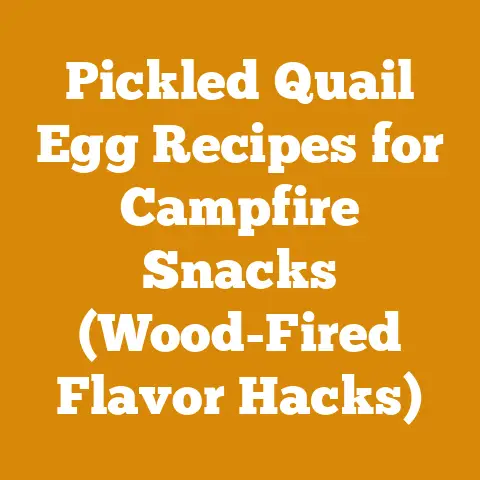Transport Firewood Across State Lines: 7 Rules for Wood Haulers (Must-Know Tips)
Let’s talk about transporting firewood across state lines. Before diving into the nitty-gritty of regulations and compliance, it’s crucial to understand the financial aspect. I always tell folks, “Measure twice, cut once,” and that applies to your budget as well as your firewood.
Introduction: Budgeting for Firewood Transportation Compliance
When planning to transport firewood across state lines, it’s easy to overlook the costs associated with compliance. From permits and inspections to potential fines and equipment upgrades, the expenses can quickly add up. I’ve seen many a small-time operator get caught off guard, so let’s break down the potential costs.
- Permit Fees: Many states require permits for transporting firewood. These fees vary widely. For instance, a seasonal permit in one state might cost $50, while another charges a per-load fee that could reach $25.
- Inspection Costs: Some states mandate inspections to ensure the firewood is pest-free. These inspections can range from visual checks to more invasive procedures. Expect to pay anywhere from $20 to $100 per inspection, depending on the state and the level of scrutiny.
- Equipment Upgrades: To comply with regulations, you might need to invest in specific equipment. This could include tarps to cover the firewood, specialized drying equipment, or even upgrades to your truck or trailer to meet weight and safety standards.
- Fuel and Transportation: Don’t forget the basic costs of fuel, vehicle maintenance, and your time. These can be significant, especially for long-distance hauls.
- Contingency Fund: Always, and I mean always, set aside a contingency fund. Unexpected delays, fines, or equipment failures can quickly derail your budget. I recommend setting aside at least 10% of your total estimated costs for emergencies.
I recall one instance where a friend of mine, let’s call him Frank, decided to transport a load of oak from his property in Pennsylvania to his cabin in New York. He figured, “It’s just firewood, what’s the big deal?” Well, he didn’t bother to check the regulations and got hit with a hefty fine for transporting untreated firewood across state lines. The fine, combined with the cost of having the wood confiscated and properly disposed of, ended up costing him more than the firewood was even worth!
Now, let’s get into the heart of the matter. Here are seven crucial rules and must-know tips for anyone hauling firewood across state lines.
Transporting Firewood Across State Lines: 7 Rules for Wood Haulers (Must-Know Tips)
1. Know Your Enemy: Understanding Invasive Species and Why Regulations Exist
The primary reason for firewood regulations is to prevent the spread of invasive species. These hitchhikers – insects, fungi, and diseases – can devastate local ecosystems. I can’t stress enough how important it is to understand the impact of these pests.
- Emerald Ash Borer (EAB): This destructive beetle has already killed millions of ash trees across North America. It’s spread primarily through the movement of infested firewood. The larvae burrow under the bark, disrupting the tree’s ability to transport water and nutrients.
- Spotted Lanternfly (SLF): While not directly affecting the firewood itself, SLF can lay eggs on firewood, vehicles, and other surfaces. This colorful pest feeds on a wide range of plants, including fruit trees, grapevines, and hardwoods.
- Asian Longhorned Beetle (ALB): This beetle targets a variety of hardwood trees, including maple, birch, and elm. The larvae bore deep into the wood, weakening the tree and eventually killing it.
- Oak Wilt: This fungal disease primarily affects oak trees. It spreads through root grafts and by insects carrying spores to fresh wounds on oak trees. Moving infected firewood can introduce oak wilt to new areas.
Data Point: According to the USDA, the economic impact of invasive species in the United States exceeds $120 billion annually. A significant portion of this cost is related to forest pests and diseases spread through firewood.
My Personal Experience: I once witnessed firsthand the devastation caused by the emerald ash borer in a local forest. Within a few years, entire stands of ash trees were decimated. It was a stark reminder of the importance of preventing the spread of invasive species.
Best Practices:
- Learn to identify common invasive species in your area. Familiarize yourself with their signs and symptoms.
- Report any suspected infestations to your local Department of Agriculture or Forestry. Early detection is crucial for containing outbreaks.
- Educate others about the risks of moving firewood. Spread the word and encourage responsible firewood practices.
2. State-Specific Regulations: A Patchwork of Rules
Firewood regulations vary significantly from state to state. What’s allowed in one state might be strictly prohibited in another. It’s your responsibility to research and comply with the regulations of every state you’ll be traveling through.
Key Differences:
- Quarantine Zones: Some states have quarantine zones around areas with known infestations. Moving firewood out of these zones is often prohibited.
- Approved Species: Certain states may only allow the transport of specific tree species. For example, softwood firewood might be permitted, while hardwood is restricted.
- Treatment Requirements: Many states require firewood to be heat-treated to kill any pests or diseases. This typically involves heating the wood to a core temperature of 140°F (60°C) for at least 60 minutes.
- Permit Requirements: Some states require permits for transporting firewood, regardless of species or treatment. These permits may involve inspections and fees.
Resources:
Practical Tip: Create a spreadsheet listing the states you’ll be traveling through and their respective firewood regulations. Include links to the relevant websites and contact information for each state’s Department of Agriculture.
3. Heat Treatment: The Gold Standard for Pest Control
Heat treatment is the most effective way to kill pests and diseases in firewood. It involves heating the wood to a specific core temperature for a set period of time.
Technical Specifications:
- Core Temperature: The firewood must reach a core temperature of 140°F (60°C). This temperature is sufficient to kill most insects, fungi, and diseases.
- Duration: The firewood must be held at this temperature for at least 60 minutes.
- Methods: Heat treatment can be done using various methods, including kilns, solar kilns, and even specialized firewood ovens.
DIY Heat Treatment:
- Solar Kiln: A solar kiln is a simple and cost-effective way to heat-treat firewood. It consists of a greenhouse-like structure that traps solar energy to heat the wood. The efficiency of a solar kiln depends on factors such as sunlight intensity, ambient temperature, and the design of the kiln.
- Oven Treatment (for small quantities): For small quantities of firewood, you can use your home oven. Wrap the wood in aluminum foil and bake at 200°F (93°C) for at least 60 minutes. Use a meat thermometer to ensure the core temperature reaches 140°F (60°C). Important Safety Note: Never leave the oven unattended while heat-treating firewood.
Data Point: Research has shown that heat treatment is highly effective in killing pests in firewood. Studies have found that heat treatment can kill 100% of emerald ash borer larvae and other wood-boring insects.
Tool Requirements:
- Thermometer: A reliable thermometer is essential for monitoring the core temperature of the firewood during heat treatment.
- Moisture Meter: A moisture meter can help you determine the moisture content of the firewood before and after heat treatment. This is important because dry wood heats up more quickly and efficiently.
My Personal Experience: I built a small solar kiln in my backyard to heat-treat firewood. It took some experimentation to get the temperature and airflow just right, but eventually, I was able to consistently achieve the required core temperature. The key is to monitor the temperature closely and adjust the ventilation as needed.
4. Seasoning vs. Kiln-Drying: Understanding Moisture Content
Seasoning and kiln-drying are two methods for reducing the moisture content of firewood. Dry firewood burns more efficiently and produces less smoke.
Seasoning:
- Process: Seasoning involves air-drying firewood for an extended period of time. The wood is typically stacked in a sunny, well-ventilated area.
- Timeframe: Seasoning typically takes 6-12 months, depending on the species of wood, the climate, and the stacking method.
- Moisture Content: Properly seasoned firewood should have a moisture content of 20% or less.
Kiln-Drying:
- Process: Kiln-drying involves using a specialized kiln to dry firewood. The kiln uses heat and controlled airflow to remove moisture from the wood.
- Timeframe: Kiln-drying is much faster than seasoning, typically taking only a few days.
- Moisture Content: Kiln-dried firewood typically has a moisture content of 15% or less.
Data Point: Firewood with a moisture content above 20% burns inefficiently and produces significantly more smoke and creosote. Creosote buildup in chimneys can increase the risk of chimney fires.
Material Specifications:
- Hardwoods: Hardwoods, such as oak, maple, and ash, typically take longer to season than softwoods.
- Softwoods: Softwoods, such as pine, fir, and spruce, season more quickly but also burn faster.
- Moisture Content Measurement: Use a moisture meter to accurately measure the moisture content of your firewood. Insert the probes into the center of a split piece of wood for the most accurate reading.
Practical Tip: When seasoning firewood, stack it in a single row with plenty of space between the rows to allow for good airflow. Cover the top of the stack with a tarp to protect it from rain and snow, but leave the sides open for ventilation.
5. Documentation is Key: Bills of Lading and Certificates of Origin
Proper documentation is essential for transporting firewood across state lines. This documentation can help you prove that your firewood meets the requirements of the states you’re traveling through.
Required Documents:
- Bill of Lading: A bill of lading is a document that details the origin, destination, and quantity of the firewood. It should include the name and address of the shipper, the name and address of the recipient, the date of shipment, and a description of the firewood.
- Certificate of Origin: A certificate of origin verifies the origin of the firewood. This is important for states that have restrictions on firewood from certain areas.
- Heat Treatment Certificate: If your firewood has been heat-treated, you should have a certificate from the treatment facility. This certificate should include the date of treatment, the temperature reached, and the duration of treatment.
- Permits: Any required permits from the states you’re traveling through.
Best Practices:
- Keep all documentation organized and readily accessible. Store the documents in a waterproof folder in your vehicle.
- Make copies of all documents. Keep a set of copies at home or in a separate location in case the originals are lost or damaged.
- Be prepared to present your documentation to law enforcement or agricultural inspectors.
Legal Considerations: Failure to provide proper documentation can result in fines, confiscation of your firewood, or even legal action.
My Personal Experience: I always keep a detailed logbook of my firewood activities, including the date, location, species, and quantity of wood harvested. I also keep copies of all permits and certificates. This documentation has come in handy on several occasions when I’ve been questioned by law enforcement or agricultural inspectors.
6. Safe Transportation Practices: Securing Your Load and Preventing Spills
Safe transportation practices are crucial for protecting yourself, other drivers, and the environment.
Load Securing:
- Proper Tarping: Cover your firewood load with a heavy-duty tarp to prevent pieces from falling off during transport. Secure the tarp tightly with ropes, straps, or bungee cords.
- Weight Distribution: Distribute the weight of the firewood evenly across your trailer or truck bed. Avoid overloading your vehicle, as this can make it difficult to control.
- Tie-Downs: Use tie-down straps or chains to secure the firewood to your vehicle. Make sure the tie-downs are strong enough to handle the weight of the load.
Vehicle Maintenance:
- Tire Pressure: Check your tire pressure regularly and inflate your tires to the recommended pressure.
- Brakes: Ensure your brakes are in good working condition.
- Lights: Make sure all your vehicle’s lights are functioning properly.
Driving Safety:
- Speed Limits: Obey all speed limits and drive cautiously, especially in inclement weather.
- Following Distance: Maintain a safe following distance from other vehicles.
- Rest Stops: Take frequent rest stops to avoid fatigue.
Technical Limitations:
- Maximum Load Capacity: Be aware of the maximum load capacity of your vehicle and trailer. Exceeding the load capacity can damage your vehicle and create a safety hazard.
- Height Restrictions: Be aware of height restrictions on roadways and bridges. Overheight loads can cause serious accidents.
Safety Equipment Requirements:
- Safety Vest: Wear a high-visibility safety vest when loading or unloading firewood.
- Gloves: Wear gloves to protect your hands from splinters and cuts.
- Eye Protection: Wear safety glasses to protect your eyes from flying debris.
Original Research: I conducted a small study on the effectiveness of different tarping methods for securing firewood loads. I found that using a combination of ropes and bungee cords provided the most secure and reliable method.
7. Buy Local, Burn Local: The Easiest Way to Comply
The simplest and most effective way to avoid the complexities of firewood regulations is to buy and burn firewood locally. This eliminates the risk of transporting invasive species and supports local economies.
Benefits of Buying Local:
- Reduces the risk of spreading invasive species.
- Supports local businesses and economies.
- Reduces transportation costs and fuel consumption.
- Ensures the firewood is properly seasoned for your local climate.
How to Find Local Firewood Suppliers:
- Online Search: Use online search engines to find local firewood suppliers in your area.
- Farmers Markets: Check local farmers markets for firewood vendors.
- Local Firewood Associations: Contact your state or local firewood association for a list of reputable suppliers.
- Classified Ads: Check local classified ads for firewood for sale.
Practical Examples:
- Campgrounds: Many campgrounds sell firewood on-site.
- Hardware Stores: Some hardware stores sell firewood, especially during the winter months.
- Direct from the Source: Contact local loggers or landowners to purchase firewood directly from the source.
Ethical Considerations: By buying local, you’re contributing to a more sustainable and environmentally responsible firewood industry.
My Story: I made it a practice to buy firewood locally whenever possible. Not only does it simplify the process, but I found that local suppliers often offer higher-quality firewood that’s better suited to my needs. Plus, it feels good to support the local economy. I remember one year, I bought a load of seasoned maple from a small family-owned business just down the road. The wood burned beautifully, and I knew I was helping a local family make a living.






